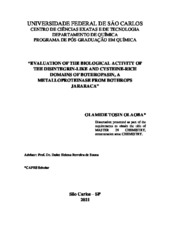| dc.contributor.author | Olaoba, Olamide Tosin | |
| dc.date.accessioned | 2021-05-20T19:19:57Z | |
| dc.date.available | 2021-05-20T19:19:57Z | |
| dc.date.issued | 2021-05-17 | |
| dc.identifier.citation | OLAOBA, Olamide Tosin. Evaluation of the biological activity of the disintegrin-like and cysteine-rich domains of Bothropasin, a metalloproteinase from Bothrops jararaca. 2021. Dissertação (Mestrado em Química) – Universidade Federal de São Carlos, São Carlos, 2021. Disponível em: https://repositorio.ufscar.br/handle/ufscar/14288. | * |
| dc.identifier.uri | https://repositorio.ufscar.br/handle/ufscar/14288 | |
| dc.description.abstract | Bothropasin is a 48kDa hemorrhagic class III Snake Venom Metalloproteinase (SVMP). As a multi-domain protein, it contains catalytic metalloproteinase (M), disintegrin-like (D), and cysteine rich domains (C). Integrins belong to the superfamily of transmembrane cell adhesion receptor that interact and bind to soluble ligands, cell-surface ligands, and extracellular matrix ligands such as collagen. The integrin-binding motif of bothropasin unlike the P-II members (that contain RGD-motif) is an ECD tripeptide. It was previously reported that cysteine (C) and aspartate (D) of the ECD were responsible for disulfide formation and calcium interaction respectively, while the glutamate (E) was found exposed to solvent and free to make interaction. Thus, we propose that (E) may also be responsible for integrin binding. Furthermore, in the current project, we intend to further ascertain the role of glutamate in integrin binding via the ability of this protein to inhibit adhesion of HUVECs (cell lines that can also express α2β1 integrin) to collagen1-coated wells. Previously in our group two clones were built to express the bothropasin DC domains (BDC) containing ECD motif (BDC-ECD protein) and the mutant ACD (BDC-ACD protein). The clones were transformed in E. coli (BL21(DE3) and DH5α) and the expression was induced by IPTG. The soluble fractions of the proteins were purified with affinity chromatography, analyzed with 15 % SDS-PAGE and western blotting; and we investigated the effect of glutamate mutation on the ability of these proteins (in fusion with GST) to inhibit cell adhesion. The result showed that the proteins did not inhibit adhesion of HUVECs to collagen 1. Although the result indicate that pretreatment of HUVEC cells with GST GST only did not affect protein activities, there is a possibility that GST in fusion with this protein could interfere with protein native folding and culminate in protein inactivities. The current data thus suggest the use of proteins free from GST for further studies. | eng |
| dc.description.sponsorship | Coordenação de Aperfeiçoamento de Pessoal de Nível Superior (CAPES) | por |
| dc.language.iso | eng | eng |
| dc.publisher | Universidade Federal de São Carlos | por |
| dc.rights | Attribution-NonCommercial-NoDerivs 3.0 Brazil | * |
| dc.rights.uri | http://creativecommons.org/licenses/by-nc-nd/3.0/br/ | * |
| dc.subject | Bothropasin | eng |
| dc.subject | Disintegrin-like domain | eng |
| dc.subject | ECD-integrin motif | eng |
| dc.subject | Inhibition Of cell adhesion | eng |
| dc.title | Evaluation of the biological activity of the disintegrin-like and cysteine-rich domains of Bothropasin, a metalloproteinase from Bothrops jararaca | eng |
| dc.title.alternative | Avaliação da atividade biológica dos domínios tipo-desintegrina e rico em cisteína da Botropasina, uma metaloproteinase de Bothrops jararaca | por |
| dc.type | Dissertação | por |
| dc.contributor.advisor1 | Souza, Dulce Helena Ferreira de | |
| dc.contributor.advisor1Lattes | http://lattes.cnpq.br/3428955299526003 | por |
| dc.description.resumo | A botropasina é uma proteína hemorrágica de 48 kDa da classe PIII das Metaloproteinase de veneno de serpentes (SVMP). Como uma proteína de múltiplos domínios, ela contém o domínio catalítico, domínios do tipo desintegrina e rico em cisteína. As integrinas pertencem à superfamília de receptores de adesão celular transmembrana que interagem e se ligam a ligantes solúveis, ligantes de superfície celular e ligantes de matriz extracelular, como o colágeno. O motivo de ligação à integrina da botropasina, ao contrário dos membros P-II (que contêm o motivo RGD), é um tripeptídeo ECD. Foi relatado anteriormente que a cisteína (C) e o aspartato (D) do ECD foram responsáveis pela formação de dissulfeto e interação de cálcio, respectivamente, enquanto o glutamato (E) foi encontrado exposto ao solvente e livre para fazer interação. No presente trabalho pretendemos averiguar a função do glutamato (E) na ligação (e na inibição) da proteína à integrina α2β1, expressa por células HUVECs. Previamente em nosso grupo dois clones foram construídos para expressar os domínios DC da botropasina (BDC) contendo o motivo ECD (proteína BDC-ECD) e o mutante ACD (proteína BDC-ACD, onde o E foi mutado por alanina). Os clones foram transfomados em E. coli (BL21(DE3) e DH5α) e a expressão das proteínas foi induzida por IPTG. As frações solúveis das proteínas foram purificadas por cromatografia de afinidade, analisadas com SDS-PAGE 15% e Western blotting e investigamos o efeito da mutação do glutamato na capacidade dessas proteínas (em fusão com a GST) de inibir a adesão celular. O resultado mostrou que as proteínas não inibiram a adesão de HUVECs ao colágeno 1. Embora o resultado indique que o pré-tratamento de células HUVEC com GST GST apenas não afetou as atividades da proteína, existe a possibilidade de que GST em fusão com esta proteína poderia interferir com o dobramento nativo da proteína e culminar em inatividades de proteínas. Os dados atuais sugerem, portanto, o uso de proteínas isentas de GST para estudos posteriores. | por |
| dc.publisher.initials | UFSCar | por |
| dc.publisher.program | Programa de Pós-Graduação em Química - PPGQ | por |
| dc.subject.cnpq | CIENCIAS BIOLOGICAS::BIOQUIMICA::BIOLOGIA MOLECULAR | por |
| dc.subject.cnpq | CIENCIAS BIOLOGICAS::BIOQUIMICA::ENZIMOLOGIA | por |
| dc.subject.cnpq | CIENCIAS BIOLOGICAS::BIOQUIMICA::QUIMICA DE MACROMOLECULAS::PROTEINAS | por |
| dc.description.sponsorshipId | CAPES: Código de Financiamento 001 | por |
| dc.publisher.address | Câmpus São Carlos | por |
| dc.contributor.authorlattes | http://lattes.cnpq.br/9341270254432200 | por |


